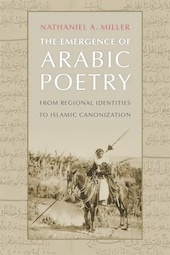
Miller (Nathaniel A.), The Emergence of Arabic Poetry. From Regional Identities to Islamic Canonization, Philadelphia, University of Pennsylvania Press, 2024, 400 p. ISBN 9781512825305
Keywords: Arabic poetry; Quran; Islamic history; late antiquity; Byzantine; Koran; Arabic language; Arabic literature; Roman Sasanian late antique history; Najdi; Hijazi; Persian Roman culture; masculinity; horsemanship; wine; kingship; dictionaries grammars; medieval history; pre-Islamic culture; Exegesis; philology philologist; reception; interpretation; hermeneutics; scripture; Arab identity formation; anachronism; nomadic tribe clan; poetic tradition
Contents
Note on Transliteration, Translations, Dates, and Sources
List of Abbreviations
Introduction
PART I. FROM “PRE-ISLAMIC” TO LATE ANTIQUE TRIBALISMS
Chapter 1. Beyond the Jāhiliyyah: How Najdi Poetics Became Classical Arabic Poetry
Chapter 2. The Background to the Najdi-Hijazi Dichotomy: Arabians and Late Antique Empires Before 500CE
Chapter 3. Development of Najdi and Hijazi Identities in Poetic Sources (500–622)
PART II. HIJAZI AND NAJDI REGIONAL IDENTITIES (500–632)
Chapter 4. Poetics of the Najdi Warrior Elite
Chapter 5. Hijazi Counterpoetics: The Case of Hudhayl
Chapter 6. Imagined Geographies
Chapter 7. Hijazi Imagined Geographies
PART III. ISLAM AND THE ASCENT OF NEO-NAJDI POETICS (632–750)
Chapter 8. Poets as Tribal Spokesmen in Early Islam (Before 692)
Chapter 9. Najdi Poetic Construction of Universal Arabo-Islam (After 692)
Conclusion
Appendix of Arabic Texts
Notes
Works Cited
Index
Acknowledgments
